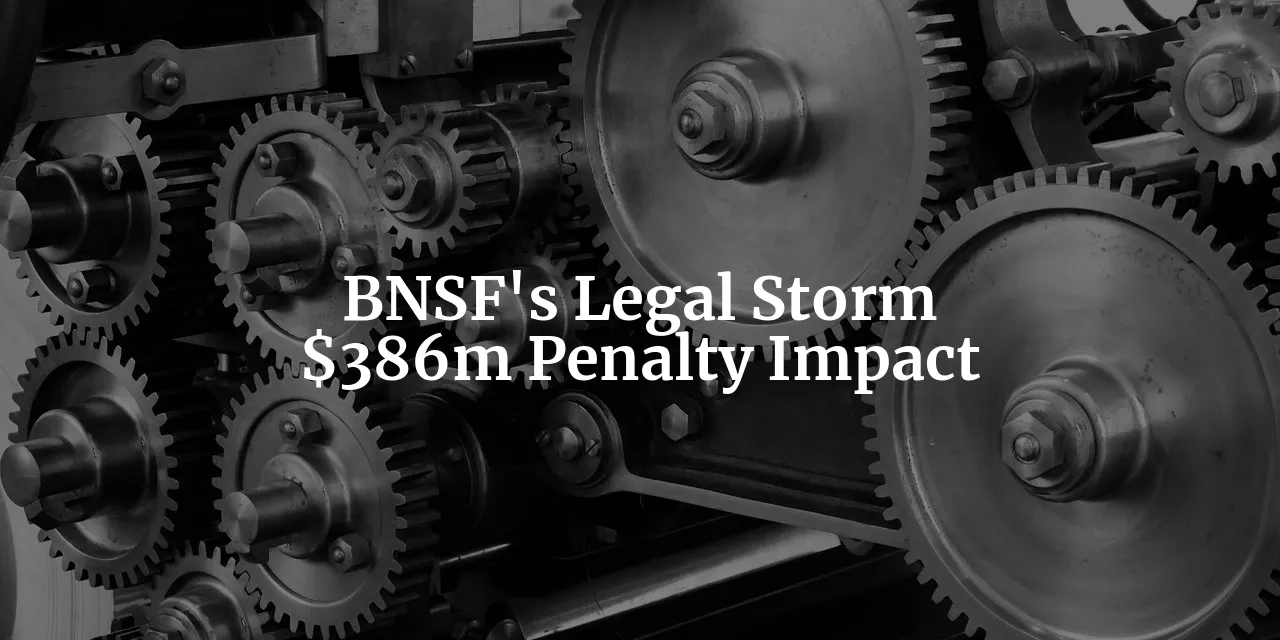Tags: BNSF / ESG
This fanpage is not officially affiliated with Berkshire Hathaway: Disclaimer
Berkshire Hathaway's BNSF is facing a $394 million penalty. We shine light on the issue, covering legal battles, economic impacts, and strategic adjustments. Explore the economic and cultural impacts, regulatory landscape, and the BNSF's commitment to sustainability.

Introduction
In 2010, Berkshire Hathaway, under the visionary leadership of Warren Buffett, made a landmark acquisition by purchasing BNSF Railway. This strategic move was not just a testament to Buffett’s acumen but also underscored the significance of BNSF within Berkshire's diversified portfolio. As one of the largest railroad systems in North America, BNSF has been a cornerstone in Berkshire Hathaway's investment strategy, contributing significantly to its financial health and operational prowess.
Recently, BNSF has found itself at the center of a legal maelstrom, resulting in a court ruling that mandates the company to pay nearly $400 million to the Swinomish Indian Tribal Community ↗ ↗. This judgment, stemming from a breach of an easement agreement, has profound implications for BNSF and, by extension, Berkshire Hathaway. The gravity of this situation cannot be overstated, as it not only affects financial performance but also raises questions about operational compliance and corporate responsibility.
BNSF's journey is one of remarkable growth and transformation ↗. Based in Fort Worth, Texas, BNSF operates an extensive rail network that spans major cities and ports across the western and southern United States, Canada, and Mexico1. With approximately 37,000 employees—the majority of whom are union members—BNSF has played a pivotal role in the transportation of products from manufacturing, agricultural, and natural resource industries 1. This vast network and workforce underscore BNSF's critical role in the North American rail industry.
The importance of BNSF in the U.S. economy cannot be overstated. By transporting a diverse array of goods, BNSF ensures the seamless functioning of supply chains across various sectors. In 2023, BNSF's freight revenues were derived from consumer products (34%), industrial products (25%), agricultural products (24%), and coal (17%)1. These figures highlight BNSF's integral role in supporting economic activities and maintaining the flow of essential commodities across the continent.
This article aims to provide a comprehensive understanding of the legal battle between BNSF and the Swinomish Tribe. By delving into the details of the case, its ramifications, and the broader context within the rail industry, we hope to shed light on the complexities and challenges that BNSF faces. Our goal is to equip shareholders with the knowledge needed to navigate this turbulent period and understand its potential impact on their investments. The article is structured to offer a detailed analysis of the legal case, starting with the background of the easement agreement and the subsequent breach by BNSF. We will then explore the court ruling, the financial implications of the penalty, and BNSF's response. Additionally, we will provide insights into the historical and cultural significance of the Swinomish Tribe, the economic and environmental implications of the case, and the strategic adjustments BNSF may need to consider moving forward. Please note that we do not pass judgment on BNSF's actions or on the Swinomish Tribe for exercising their constitutional rights. These matters are appropriately decided in the courtroom.
As Warren Buffett once said, "Risk comes from not knowing what you're doing." This quote resonates deeply as we delve into the intricacies of the BNSF legal case. Understanding the details and implications of this situation is crucial for shareholders, as it not only affects the financial bottom line but also reflects on the ethical and operational standards of one of Berkshire Hathaway's most significant investments.
The Legal Battle: Swinomish Tribe vs. BNSF
In 1991, BNSF entered into an Easement Agreement with the Swinomish Tribe, granting the railway limited use of tracks that crossed the Swinomish Reservation 2. The agreement stipulated strict limits on the number of trains and required BNSF to provide regular updates on the cargo being transported. Specifically, the agreement allowed only one train in each direction per day, with no more than 25 cars per train2.
However, BNSF breached this agreement by failing to update the Tribe on the cargo and unilaterally increasing the number of trains and cars without the Tribe's consent 2. This breach became particularly egregious in 2012, when BNSF began transporting Bakken crude oil—known for its volatility and safety risks—across the reservation without informing the Tribe 2.
The Swinomish Tribe, deeply concerned about the safety and environmental risks posed by the increased rail traffic, as well as the impact on their fishing activities, decided to take legal action against BNSF in 2015 2. The Tribe highlighted the dangers of transporting Bakken crude oil, which is easier to ignite, and the potential for environmental disasters in their sensitive marine ecosystems 34. The increased rail traffic also interfered with the Tribe's fishing activities, particularly affecting their access to Padilla Bay 2.
The court ruled in favor of the Swinomish Tribe, finding that BNSF had intentionally trespassed by running 100-car trains on the reservation, far exceeding the agreed limits 34. The judge ordered BNSF to pay nearly $400 million in penalties, which included $362 million in ill-gotten profits and $32 million in post-tax profits 34. This ruling underscores the seriousness of BNSF's breach and the substantial financial repercussions it faces.
| Position | Amount |
|---|---|
| Ill-gotten profits | $362 million |
| Post-tax profits | $32 million |
| Total Penalty | $394 million |
In response to the judgment, BNSF has remained largely silent, offering no public comment on the ruling 34. However, the Swinomish Tribe expects BNSF to appeal the decision, which could prolong the legal battle and add further uncertainty to the situation 34.
The Swinomish Tribe has a rich history and cultural heritage, deeply intertwined with the marine resources of their region 5. As Lushootseed-speaking Indigenous people, the Swinomish have traditionally relied on salmon fishing and shellfish gathering for their livelihood 5. The increased rail traffic not only posed environmental risks but also threatened their way of life, making the legal battle with BNSF not just a matter of compliance, but one of preserving their cultural and historical legacy. In turn, the legal battle between BNSF and the Swinomish Tribe is a complex and multifaceted issue with significant implications for Berkshire Hathaway.
Economic and Environmental Implications
The $394 million penalty imposed on BNSF as a result of the legal battle with the Swinomish Tribe is a significant financial burden ↗. For BNSF, which saw a 6.9% decline in operating revenues and a 14.2% drop in pre-tax earnings in 2023 ↗, this penalty exacerbates an already challenging financial landscape 1. Given that BNSF is a subsidiary of Berkshire Hathaway, this penalty also has broader implications for Berkshire's overall asset portfolio, valued at approximately $1,069 billion 1. Shareholders may be concerned about the potential impact on stock prices and dividends, as this legal storm could strain BNSF's contribution to Berkshire's financial health.
BNSF's freight revenues are a critical component of its financial performance, with 34% derived from consumer products, 25% from industrial products, 24% from agricultural products, and 17% from coal in 2023 1. The decline in operating revenues and pre-tax earnings in 2023 highlights the vulnerability of BNSF to broader economic conditions. As a common carrier, BNSF's revenues are influenced by contractual agreements, published prices, and company quotations, making it susceptible to market fluctuations and regulatory changes.
Environmental regulations add a layer of complexity to BNSF's operations. The company is required to transport hazardous materials, which increases operational costs and liabilities. Compliance with regulations set by agencies like the EPA and DOT is essential, but it also means higher expenses related to safety measures and potential cleanup costs 1. BNSF's commitment to reducing GHG emissions by 30% by 2030 and its exploration of battery-electric and hydrogen locomotives are steps towards mitigating environmental impact, but they come with significant financial investments 1.
The safety of rail operations is paramount, and BNSF is subject to oversight by multiple regulatory bodies, including the STB, OSHA, and EPA 16 ↗. These agencies regulate various aspects of rail operations, from safety and health to environmental compliance. The USDOT's emphasis on safety, especially in light of recent high-profile derailments, underscores the importance of stringent safety protocols and advanced inspection technologies. BNSF's adherence to these regulations is crucial for maintaining operational integrity and avoiding further penalties.
For Berkshire Hathaway, the $394 million penalty and ongoing legal battles pose potential risks. The financial strain on BNSF could lead to reduced contributions to Berkshire's overall earnings, impacting stock prices and dividends. Shareholders must consider the long-term implications of these legal and regulatory challenges on their investments.
BNSF's primary competitor, Union Pacific Railroad, faces similar regulatory and economic challenges. Both companies are navigating a landscape marked by stringent safety regulations, environmental compliance requirements, and economic pressures. However, BNSF's recent financial setbacks and legal issues may place it at a relative disadvantage compared to Union Pacific. The competitive dynamics between these two rail giants will be crucial in shaping their future strategies and market positions 1.
BNSF needs to strategically adjust to mitigate future risks. Investments in green technologies, such as battery-electric and hydrogen locomotives, are essential for reducing environmental impact and complying with regulations 17. Additionally, enhancing safety measures and adopting advanced inspection technologies will be critical in preventing derailments and ensuring regulatory compliance. BNSF's ability to navigate these challenges will determine its long-term viability and success.
Broader Historical and Political Context
The development of U.S. railroads has a rich history, marked by significant milestones such as the Staggers Rail Act of 1980, which partially deregulated the freight rail industry 7. This act allowed railroads to set their own rates and enter into contracts, fostering competition and improving efficiency. The historical context of U.S. railroads also includes the establishment of Amtrak in 1971 to address the decline of passenger rail services and the significant role railroads played in connecting the East and West Coasts in the 19th century.
The political landscape surrounding rail infrastructure investment has seen renewed focus ↗, particularly with the allocation of funds in the Infrastructure Investment and Jobs Act (IIJA). This bipartisan effort aims to enhance rail safety and modernize infrastructure, with $102 billion earmarked for rail funding, including $66 billion for Amtrak 7. These investments reflect a broader commitment to improving the nation's rail systems and addressing longstanding safety and infrastructure issues.
Deregulation and industry consolidation have had profound effects on rail safety and competition. The proposed merger of Canadian Pacific Railway and Kansas City Southern, which received federal approval in March 2023, is a recent example of industry consolidation 7. While consolidation can lead to operational efficiencies, it also raises concerns about reduced competition and job losses. The introduction of precision-scheduled railroading has been criticized for prioritizing efficiency over safety, contributing to a perceived regression in rail safety standards.
High-profile derailments, such as the Norfolk Southern incident in East Palestine, have significantly shaped public and political attitudes towards rail safety 67. These incidents highlight the vulnerabilities in the rail system and underscore the need for stringent safety measures. The public outcry and regulatory scrutiny following such events have prompted calls for enhanced safety protocols and greater accountability within the industry.
In response to recent rail safety concerns, government agencies and regulators have proposed several measures to enhance worker protections and increase fines for violations 67. The USDOT's commitment to advancing the Train Crew Staffing Rule and deploying new inspection technologies reflects a proactive approach to improving rail safety. Additionally, the NTSB's investigation into high-profile derailments underscores the importance of thorough oversight and accountability.
The current situation with BNSF and the broader rail industry draws parallels to historical events, such as early 20th-century labor disputes and the evolution of rail safety standards. Just as labor disputes in the past led to significant changes in worker protections and safety regulations, today's challenges may similarly drive reforms aimed at enhancing safety and operational integrity.
Broader economic and cultural shifts have also influenced the rail industry. The rise of car commuting and the decline of passenger rail services reflect changing transportation preferences and infrastructure investments 7. Despite these shifts, freight rail remains a crucial component of the U.S. supply chain, offering a more environmentally friendly and cost-effective alternative to trucking. The ongoing exploration of green technologies and high-speed rail projects signals a potential shift towards more sustainable and efficient rail systems in the future.
Strategic and Operational Adjustments
In an era where environmental concerns are at the forefront of corporate responsibility, BNSF has made significant strides towards sustainability ↗. The company has set an ambitious goal to reduce greenhouse gas (GHG) emissions by 30% by 2030. This commitment is not just a nod to regulatory pressures but a strategic move to align with global sustainability trends and investor expectations. To achieve this, BNSF is actively evaluating battery-electric and hydrogen locomotives. These technologies promise to revolutionize rail transport by significantly cutting down emissions and reducing dependency on fossil fuels 1. Such initiatives not only enhance BNSF's environmental credentials but also position it as a forward-thinking leader in the rail industry.
Safety remains a cornerstone of BNSF's operational strategy. In light of recent high-profile derailments and increasing regulatory scrutiny, BNSF has prioritized the adoption of new safety inspection technologies. These innovations are designed to detect potential issues before they escalate into major problems, thereby reducing the risk of accidents. Additionally, BNSF is expediting the phase-in of safer tank cars to ensure the secure transport of hazardous materials 6. These measures are crucial for maintaining operational integrity and protecting both the workforce and the communities through which BNSF operates.
The rail industry has faced significant workforce challenges, with Class 1 railroads cutting their workforce by almost 30% since 2016 6. For BNSF, which employs approximately 37,000 individuals—with 32,000 being members of a labor union—maintaining a robust and healthy workforce is critical. The importance of paid sick leave cannot be overstated, as it directly impacts worker health and safety. Ensuring that employees are well-rested and healthy reduces the risk of accidents and enhances overall productivity. As the industry grapples with these issues, BNSF's approach to labor relations will be pivotal in navigating the current landscape and ensuring long-term operational stability.
BNSF's extensive network is bolstered by its collaboration with approximately 200 shortline railroads. These partnerships are essential for improving efficiency and expanding market reach. By working closely with shortline railroads and having marketing agreements with other rail carriers, BNSF can offer more comprehensive service options to its customers. This collaborative approach not only enhances operational flexibility but also strengthens BNSF's position in a highly competitive market 1.
The regulatory environment for railroads is evolving, with new rules and standards being introduced to enhance safety and operational efficiency. BNSF is proactively responding to these changes, including the proposed Train Crew Staffing Rule, which would require a minimum of two crewmembers for most railroad operations 6. This rule aims to improve safety by ensuring that there are adequate personnel to handle emergencies and other operational challenges. BNSF's compliance with such regulations demonstrates its commitment to safety and regulatory adherence, which are crucial for maintaining its license to operate.
Investment in infrastructure is a critical component of BNSF's strategy. The Bipartisan Infrastructure Law has allocated substantial resources for rail infrastructure improvements, which BNSF is leveraging to maintain and enhance its rail tracks 67. These investments are essential for ensuring the reliability and safety of BNSF's operations. By upgrading infrastructure, BNSF can reduce maintenance costs, improve service reliability, and enhance overall operational efficiency.
BNSF is focused on several strategic goals to ensure its continued success. These include enhancing productivity, remaining competitive in a dynamic market, and addressing both environmental and safety challenges 1. By investing in new technologies, prioritizing safety, and fostering strong labor relations, BNSF is well-positioned to navigate the complexities of the rail industry. The company's commitment to sustainability and infrastructure investment further underscores its long-term vision of operational excellence and environmental stewardship.
As BNSF faces the complexities of a $394 million legal storm, its strategic and operational adjustments underscore a commitment to sustainability, safety, and workforce well-being. By embracing new technologies, fostering strong partnerships, and investing in infrastructure, BNSF is not only addressing current challenges but also setting the stage for a resilient and prosperous future. For shareholders, these initiatives highlight BNSF's proactive approach to maintaining its leadership in the rail industry while aligning with broader economic and environmental goals.

Conclusion
The legal battle between BNSF and the Swinomish Tribe has brought to light the intricate challenges faced by Berkshire Hathaway. The $394 million penalty imposed on BNSF not only has significant financial implications but also underscores the importance of operational compliance and corporate responsibility. The breach of the easement agreement and subsequent court ruling highlight the need for transparent communication, adherence to agreements, and proactive engagement with stakeholders.
The economic and environmental implications of the penalty for BNSF and Berkshire Hathaway are substantial, with potential impacts on stock prices, dividends, and overall financial performance. As BNSF navigates this legal storm, strategic adjustments in sustainability, safety innovations, and workforce relations are crucial for ensuring long-term success and operational integrity. The company's commitment to infrastructure investment, regulatory compliance, and collaboration with shortline railroads will be instrumental in maintaining its competitive edge and market leadership.
Looking ahead, BNSF's focus on enhancing productivity, sustainability, and safety sets a positive trajectory for its future prospects. By embracing new technologies, investing in infrastructure, and fostering strong partnerships, BNSF is well-positioned to overcome current challenges and emerge as a resilient and prosperous player in the rail industry. Shareholders can take comfort in BNSF's proactive approach to addressing key issues and aligning with broader economic and environmental goals.
As we reflect on the lessons learned from this legal battle, it becomes evident that operational integrity, stakeholder engagement, and regulatory compliance are paramount in navigating the complexities of the rail industry. BNSF's strategic adjustments and commitment to sustainability serve as a testament to its resilience and adaptability in the face of adversity. The case of BNSF vs. the Swinomish Tribe serves as a reminder of the delicate balance between economic growth, social responsibility, and environmental stewardship in the modern business landscape.
In closing, the legal storm that BNSF is weathering presents an opportunity for reflection and growth, not just for the company but for the industry as a whole. By embracing change, prioritizing safety, and fostering a culture of compliance, BNSF can pave the way for a sustainable and successful future. As Berkshire Hathaway shareholders, it is essential to monitor these developments closely and recognize the broader implications of this case for the rail industry and beyond.
References
-
2023 Annual Report - www.berkshirehathaway.com ↩↩↩↩↩↩↩↩↩↩↩↩↩↩
-
Swinomish Indian Tribal Community v. BNSF Railway Company 2022 WL 3597439 - narf.org ↩↩↩↩↩↩
-
Rail firm must pay Native American tribe $400m for illegal crude oil trains - www.theguardian.com ↩↩↩↩↩
-
BNSF Railway must pay $400m to a Native American tribe - fortune.com ↩↩↩↩↩
-
Swinomish people - Wikipedia - en.wikipedia.org ↩↩
-
U.S. Department of Transportation Fact Sheet: Steps Forward on Freight Rail Industry Safety & Accountability - www.transportation.gov ↩↩↩↩↩↩↩












